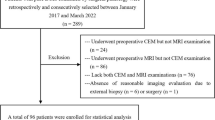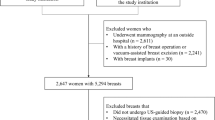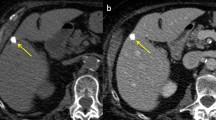Abstract
Objectives
To investigate the malignancy rate of probably benign calcifications assessed by digital magnification view and imaging and clinical features associated with malignancy.
Methods
This retrospective study included consecutive women with digital magnification views assessed as probably benign for calcifications without other associated mammographic findings from March 2009 to January 2014. Initial studies rendering a probably benign assessment were analyzed, with biopsy or 4-year imaging follow-up. Fisher’s exact test and univariable logistic regression were performed. Cancer yields were calculated.
Results
A total of 458 lesions in 422 patients were finally included. The overall cancer yield was 2.2% (10 of 458, invasive cancer [n = 4] and DCIS [n = 6]). Calcification distribution (OR = 23.80, p = .041), calcification morphology (OR = 10.84, p = .005), increased calcifications (OR = 29.40, p = .001), and having a concurrent newly diagnosed breast cancer or high-risk lesion (OR = 10.24, p = .001) were associated with malignancy. Cancer yields did not significantly differ between grouped punctate calcifications vs. calcifications with other features (1.2% [2 of 162] vs. 2.7% [8 of 296], p = .506). The cancer yield was 1.6% (7 of 437) in women without newly diagnosed breast cancer or high-risk lesions.
Conclusion
The cancer yield of probably benign calcifications assessed by digital magnification view was below the 2% threshold for grouped punctate calcifications and for women without newly diagnosed breast cancer or high-risk lesions. Calcification distribution, morphology, increase in calcifications, and the presence of newly diagnosed breast cancer/high-risk lesion were associated with malignancy.
Key Points
• Among 458 probably benign calcifications assessed by digital magnification view, the overall cancer yield was 2.2% (10 of 458).
• The cancer yield was below the 2% threshold for grouped punctate calcifications (1.2%, 2 of 162) and in women without newly diagnosed breast cancer or high-risk lesions (1.6%, 7 of 437).
• Calcification distribution, morphology, increase in calcifications, and the presence of newly diagnosed breast cancer/high-risk lesion were associated with malignancy (all p < .05).



Similar content being viewed by others
Abbreviations
- ACR:
-
American College of Radiology
- DCIS:
-
Ductal carcinoma in situ
- CI:
-
Confidence interval
References
Vizcaino I, Gadea L, Andreo L et al (2001) Short-term follow-up results in 795 nonpalpable probably benign lesions detected at screening mammography. Radiology 219:475–483
Varas X, Leborgne F, Leborgne JH (1992) Nonpalpable, probably benign lesions: role of follow-up mammography. Radiology 184:409–414
Sickles EA (1998) Findings at mammographic screening on only one standard projection: outcomes analysis. Radiology 208:471–475
Helvie MA, Pennes DR, Rebner M, Adler DD (1991) Mammographic follow-up of low-suspicion lesions: compliance rate and diagnostic yield. Radiology 178:155–158
American College of Radiology (2013) Breast imaging reporting and data system, 5th edn. American College of Radiology, Reston, VA
Liberman L, Abramson AF, Squires FB, Glassman JR, Morris EA, Dershaw DD (1998) The breast imaging reporting and data system: positive predictive value of mammographic features and final assessment categories. AJR Am J Roentgenol 171:35–40
Sickles EA (1991) Periodic mammographic follow-up of probably benign lesions: results in 3,184 consecutive cases. Radiology 179:463–468
Varas X, Leborgne JH, Leborgne F, Mezzera J, Jaumandreu S, Leborgne F (2002) Revisiting the mammographic follow-up of BI-RADS category 3 lesions. AJR Am J Roentgenol 179:691–695
Michaels A, Chung CS, Birdwell RL, Frost EP, Giess CS (2017) Imaging and histopathologic features of BI-RADS 3 lesions upgraded during imaging surveillance. Breast J 23:10–16
Lee CS, Berg JM, Berg WA (2021) Cancer yield exceeds 2% for BI-RADS 3 probably benign findings in women older than 60 years in the National Mammography Database. Radiology 299:550–558
Fischer U, Baum F, Obenauer S et al (2002) Comparative study in patients with microcalcifications: full-field digital mammography vs screen-film mammography. Eur Radiol 12:2679–2683
Lehman CD, Rutter CM, Eby PR, White E, Buist DS, Taplin SH (2008) Lesion and patient characteristics associated with malignancy after a probably benign finding on community practice mammography. AJR Am J Roentgenol 190:511–515
Hoff SR, Abrahamsen AL, Samset JH, Vigeland E, Klepp O, Hofvind S (2012) Breast cancer: missed interval and screening-detected cancer at full-field digital mammography and screen-film mammography-- results from a retrospective review. Radiology 264:378–386
Gruber R, Jaromi S, Rudas M et al (2013) Histologic work-up of non-palpable breast lesions classified as probably benign at initial mammography and/or ultrasound (BI-RADS category 3). Eur J Radiol 82:398–403
Dillon MF, McDermott EW, Quinn CM, O'Doherty A, O'Higgins N, Hill AD (2006) Predictors of invasive disease in breast cancer when core biopsy demonstrates DCIS only. J Surg Oncol 93:559–563
Kessar P, Perry N, Vinnicombe SJ, Hussain HK, Carpenter R, Wells CA (2002) How significant is detection of ductal carcinoma in situ in a breast screening programme? Clin Radiol 57:807–814
Hofvind S, Iversen BF, Eriksen L, Styr BM, Kjellevold K, Kurz KD (2011) Mammographic morphology and distribution of calcifications in ductal carcinoma in situ diagnosed in organized screening. Acta Radiol 52:481–487
Landis JR, Koch GG (1977) The measurement of observer agreement for categorical data. Biometrics 33:159–174
Haneuse S, Buist DSM, Miglioretti DL et al (2012) Mammographic interpretive volume and diagnostic mammogram interpretation performance in community practice. Radiology 262:69–79
Brodersen J, Siersma VD (2013) Long-term psychosocial consequences of false-positive screening mammography. Ann Fam Med 11:106–115
Oligane HC, Berg WA, Bandos AI et al (2018) Grouped amorphous calcifications at mammography: frequently atypical but rarely associated with aggressive malignancy. Radiology 288:671–679
Lazarus E, Mainiero MB, Schepps B, Koelliker SL, Livingston LS (2006) BI-RADS lexicon for US and mammography: interobserver variability and positive predictive value. Radiology 239:385–391
Lee AY, Wisner DJ, Aminololama-Shakeri S et al (2017) Inter-reader variability in the use of BI-RADS descriptors for suspicious findings on diagnostic mammography: a multi-institution study of 10 academic radiologists. Acad Radiol 24:60–66
Lei C, Wei W, Liu Z et al (2019) Mammography-based radiomic analysis for predicting benign BI-RADS category 4 calcifications. Eur J Radiol 121:108711
Stelzer PD, Steding O, Raudner MW, Euller G, Clauser P, Baltzer PAT (2020) Combined texture analysis and machine learning in suspicious calcifications detected by mammography: potential to avoid unnecessary stereotactical biopsies. Eur J Radiol 132:109309
Liu H, Chen Y, Zhang Y et al (2021) A deep learning model integrating mammography and clinical factors facilitates the malignancy prediction of BI-RADS 4 microcalcifications in breast cancer screening. Eur Radiol 31:5902–5912
Acknowledgements
This study was supported by a faculty research grant of Yonsei University College of Medicine for 2019 (6-2019-0178). The funders had no role in study design, data collection and analysis, decision to publish, or preparation of the manuscript.
Funding
This study was supported by a faculty research grant of Yonsei University College of Medicine for 2019 (6-2019-0178). The funders had no role in study design, data collection and analysis, decision to publish, or preparation of the manuscript.
Author information
Authors and Affiliations
Corresponding author
Ethics declarations
Guarantor
The scientific guarantor of this publication is Vivian Youngjean Park
Conflict of interest
The authors declare no competing interests.
Statistics and biometry
Biostatistics Collaboration Unit of Yonsei University College of Medicine kindly provided statistical advice for this manuscript.
Informed consent
Written informed consent was waived by the Institutional Review Board.
Ethical approval
Institutional Review Board approval was obtained.
Methodology
• retrospective
• observational
• performed at one institution
Additional information
Publisher’s note
Springer Nature remains neutral with regard to jurisdictional claims in published maps and institutional affiliations.
Rights and permissions
About this article
Cite this article
Lee, M., Lee, S.E., Kim, H.R. et al. Cancer yield and imaging features of probably benign calcifications at digital magnification view. Eur Radiol 32, 4909–4918 (2022). https://doi.org/10.1007/s00330-022-08596-8
Received:
Revised:
Accepted:
Published:
Issue Date:
DOI: https://doi.org/10.1007/s00330-022-08596-8




